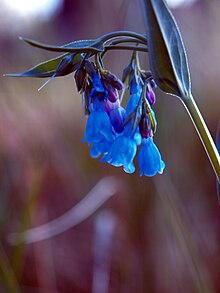Mertensia lanceolata
| Mertensia lanceolata | |
|---|---|

| |
| Scientific classification | |
| Kingdom: | Plantae |
| Clade: | Tracheophytes |
| Clade: | Angiosperms |
| Clade: | Eudicots |
| Clade: | Asterids |
| Order: | Boraginales |
| Family: | Boraginaceae |
| Genus: | Mertensia |
| Species: | M. lanceolata
|
| Binomial name | |
| Mertensia lanceolata | |
Mertensia lanceolata, known as prairie bluebells, narrow-leaved languid lady, lance-leaved bluebells, and lance-leaved lungwort[3][4][1] is a species of flowering plant native to western North America.[1] A herbaceous perennial it has blue-green leaves alternately arranged on its smooth flowering stalk. Its flower buds are pink-purple and become more blue as they open. Accepted varieties include:[5]
- Mertensia lanceolata var. coriacea (A.Nelson) L.C.Higgins & S.L.Welsh
- Mertensia lanceolata var. lanceolata
- Mertensia lanceolata var. secundorum (Cockerell) Cockerell
Description
Mertensia lanceolata is a variable species with flowering individuals typically growing 20-35 cm in height. The species is found in Rocky Mountain habitats from the plains to alpine habitats. The leaves are blue-green due to the waxy coating with a prominent center vein.[4] Immature plants will have a few distinctly lanceolate leaves arising from the ground on short stalks while plants mature enough to flower will typically have narrower leaves attached alternately attached to the flower stalk.
The leaves or flower stalks arise from the large taproot. Flowering stalks lean outwards at an angle with multiple flowers hanging downwards from the top of the stalk. The flowers are five fused petals forming a short trumpet.[6]
References
- ^ a b c "Mertensia lanceolata". NatureServe Explorer. NatureServe. Retrieved 2018-09-30.
- ^ "Mertensia lanceolata". ipni.org. International Plant Names Index. Retrieved 2018-09-30.
- ^ USDA, NRCS (n.d.). "Mertensia lanceolata". The PLANTS Database (plants.usda.gov). Greensboro, North Carolina: National Plant Data Team. Retrieved 2018-09-30.
- ^ a b Kelaidis, Panayoti. (1994). A guide to locating Rocky Mountain wildflowers. Frederick, CO: Renaissance House. p. 34. ISBN 1-55838-148-1. OCLC 31866209.
- ^ "Mertensia lanceolata". Plants of the World Online. Royal Botanical Gardens Kew. Retrieved 2018-09-27.
- ^ Ackerfield, Jennifer (2015). Flora of Colorado. Botanical Research Institute of Texas (First ed.). Fort Worth, Texas. ISBN 978-1-889878-45-4. OCLC 910162216.
{{cite book}}: CS1 maint: location missing publisher (link)

